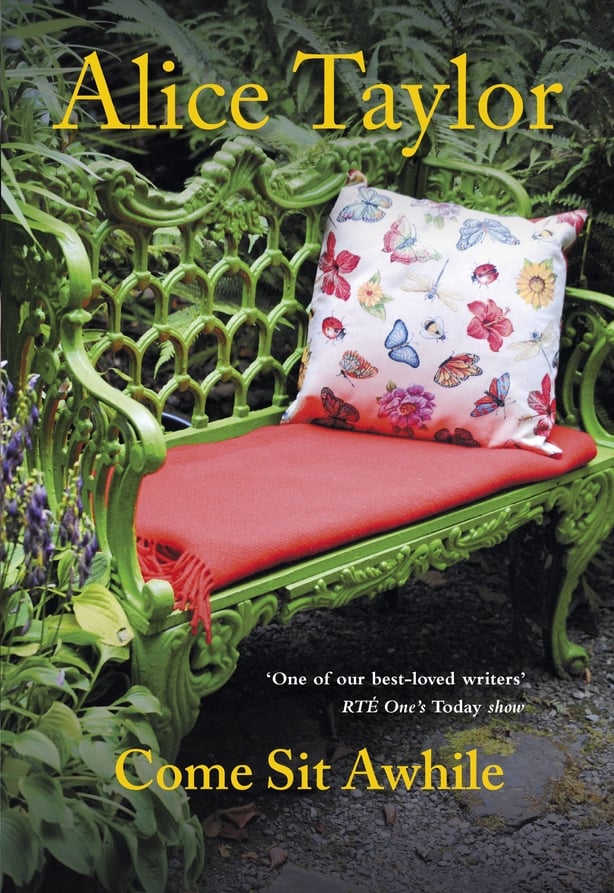We present an extract from Come Sit Awhile, the latest book by much-loved author Alice Taylor, author of To School Through the Fields.
Take a little time out – to rest, to think, or just to be. Life can race along at a fast pace, sometimes almost stampeding us along with it. What a pity not to slow down and take the time to enjoy little things, or chat with a good friend, or simply do nothing. Find a comfortable place to sit, a place to let the mind calm down and let thoughts drift. With her new book, Alice Taylor invites us to take a moment and sit awhile...
Let's Light a Candle
There are times in life when we all need the presence of another human being. Maybe to sit together in silent companionship, to discuss something that is bothering us, to chat quietly about a shared interest or to enjoy an old joke. Covid robbed us of these interactions, resulting in a certain social withdrawal that is very slowly righting itself. There is a lot of wisdom in the Ralph Waldo Emerson quote: 'Go often to the house of thy friend, for weeds choke up the unused path.’ How energising it is when an old friend calls by and you sit together enjoying a meeting of minds which leaves you feeling lighter. Even a phone chat can help move you forward.
But there are other days when friends are not available and we find it difficult to apply ourselves to what we need to do – and at such times the writings of somebody who experienced a similar situation to ourselves may echo in our mind and help us see a little kink of light that leads us on. Having a small treasury of such moments is a comfort that I cultivate. When we feel abandoned and not able to concentrate, the words of an old familiar poem, hymn or prayer can trickle into our minds and switch us back into gear. I keep a journal and also write little poems to capture fleeting moments.
This book is about taking time out, time to think, time to lift ourselves out of our everyday busy-ness.
Nature too can influence our sense of well-being. We have all known foggy, dull days when a low sky wraps a grey shroud around our shoulders and we trudge on, heavy-footed and glum-faced. And then comes a bright, sunny morning and unconsciously our step lightens, we move forward with a new sense of enthusiasm, a smile streams across our face – and suddenly it is good to be alive. We are hugely influenced by light.
Heat and light – what wonderful gifts that lift the spirit. It is so good to stop and soak them up. These moments are precious. Our ancestors knew this and had the expertise, wisdom and foresight to create the wonder of light at Newgrange, and when St Patrick lit his symbolic fire on the hill of Tara he sent shockwaves across the pagan plains of Ireland. Cathedral creators, with their awareness of the human need for morning light, faced the windows above the sanctuaries eastwards so that the rising sun could pour in and light up the minds of praying people. The symbolism of candlelight, too, beams forth from all religious traditions. At Easter the Paschal candle is lit, and at Christmas the old Irish tradition of the welcoming candle is part of who we are.
Nowadays, in our local church in Innishannon, a small candelabra constantly glows with little lighted candles. People slip in quietly to say a quick prayer and light a candle, and sometimes they pick up one of the little cards from a nearby shelf to let a friend in trouble know that a candle has been lit for them and that they are not forgotten. The comfort of this connectedness can help another keep going through tough times.
Going to the Well
Before piped water flowed into old farmhouses, water was drawn in buckets from wells in fields beside the houses. One might think that there was nothing to be learned from the drawing of water out of an old well, but the reaction of the well to the drawing off of water is a never-forgotten experience because a well is, in some way, representative of our own inner pool of creativity.
The inner recesses of our well at home were deep, enclosed and secretive, and everything around it was green. Even the large pale grey stone at the entrance was fringed along the outside with frills of green moss, and the dark water inside reflected the mossy arched stones overhead. But the arching moss turned a rich brown in the dark inner reflections of the water. When you knelt on the flat warm stone outside and peered into the well, your image wavered down and was swallowed into its cool brown interiors.
Once you plunged the white enamel bucket into these dark depths, the water at first resisted but then gave an audible gulp of surrender and overflowed into the empty bucket. And as the bucket eased upwards you sensed the well immediately refilling from the unplumbed depth of its deep reserves.
The well needed that act of drawing off water to stimulate its depths. Without this, the well would have gone stagnant. Like that well water, the inner creative pool, if never stimulated, may forever remain stagnant. Creativity generates creativity.
We sometimes limit our interpretation of creativity to the artistic pursuits of art, music and writing, but creativity also flows forth in the more mundanely perceived pursuits of baking, knitting, stitching, woodwork, gardening and many, many more activities. And when we are engaged in any of these engrossing creative pursuits all is well with our inner and, indeed, our outer world.

Come Sit Awhile is published by The O’Brien Press

